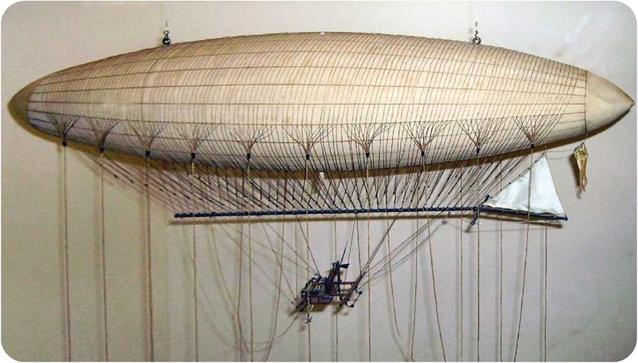The First Aircraft
Meanwhile, the airplane took the lead. When Giffard was making the first airship flight in France in 1852, Englishman George Cayley had already begun a scientific study of the forces produced by moving air, or aerodynamics. Cayley was interested in how these forces could be used by heavier-than-air flying machines.
He wrote that the challenge was “to make a surface support a given weight
by the application of power to the resistance of air.” He was talking about lift and drag, the aerodynamic forces that act on aircraft. Cayley’s work resulted in the first manned gliders in the middle of the nineteenth century.
The invention of the steam engine in the nineteenth century awakened interest in developing steam-powered airplanes. The steam engines of the day were too heavy, however. Powered airplanes had to wait until smaller, lighter engines powered by gasoline were developed in the late 1800s. That would
 |
О The Giffard steam-powered balloon made the first successful powered flight. The engine, propeller, and platform for the pilot hang beneath the 144-foot (44-meter) hydrogen-filled balloon. This model of Giffard’s balloon is now on display at the Science Museum in London, England.

lead to a usable engine for airplanes. Aeronautical pioneers, meanwhile, concentrated on learning to build stable gliders and control them in the air.
The brothers Orville and Wilbur Wright experimented with kites and gliders in a very methodical way. Each time they encountered a problem, they worked at it until they found a solution. They also designed a gasoline engine light enough to power an airplane based on one of their gliders. The brothers were finally ready to fly the world’s first successful powered airplane in 1903.
The Wright brothers had developed the airplane and shown that controlled flight was possible. Other engineers and inventors reshaped the airplane and otherwise improved it with their own ideas. The age of modern aeronautics had begun.
Otto Lilienthal (1848-1896) in Germany made more than 2,000 glider flights. Other aeronautical engineers and inventors around the world avidly read Lilienthal’s books and essays on aeronautics. The readers included Percy Pilcher in Britain and the Wright brothers and Octave Chanute in the United States. These innovators flew gliders similar to modern hang gliders. They steered by shifting their weight to one side.
Aeronautical research at that time was very risky, and accidents were common. Flimsy aircraft made of wood and fabric could fall apart, or they could spin out of control and plunge to the ground. Lilienthal and Pilcher both died as a result of aircraft crashes.
4_______________ J
Into the Modern World
The fixed-wing aircraft was not the only way to fly. Other aeronautical engineers struggled with the problems of building craft with spinning wings, called rotors. Their work led to the development of autogiros and helicopters.
All sorts of new technologies were applied to the airplane-new wing shapes, new engines, metal structures instead of wood, monoplanes instead of biplanes, more efficient propellers, more streamlined aerodynamics, and so on. Piece by piece, these and many other advances in aeronautics transformed the fragile wood-and-wire flying machines of the early twentieth century into the amazing aircraft we have today.










